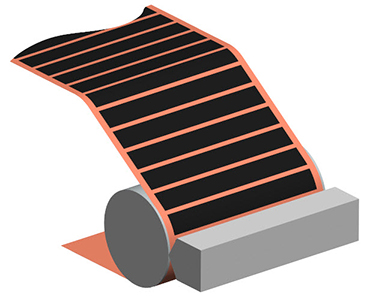Coating Matters | Patch Coating for Precision Fluid Placement, Pt. 1
- Published: September 23, 2014, By Mark Miller
If you'd like to hear from Mark Miller's own lips rather than read his column, titled "Coating Matters | Patch Coating for Precision Fluid Placement, Pt. 1," click on his podcast below:
{mp3}patch-coating-part-one{/mp3}
ABSTRACT
![]() The world has gone patch coating crazy! Batteries, pharmaceuticals, even adhesives. The interest in reducing waste and providing functional coating that can be used right off the coating station is very high. With this increased interest in intermittent coating, we also have to consider the technical challenges.
The world has gone patch coating crazy! Batteries, pharmaceuticals, even adhesives. The interest in reducing waste and providing functional coating that can be used right off the coating station is very high. With this increased interest in intermittent coating, we also have to consider the technical challenges.
Every coating process has a start and stop. In patch coating, this occurs more often than not at the beginning and end of a roll. Of course, the steady-state continuous flow in between starting and stopping has been discussed at length and has its own issues to deal with. But what special issues are associated with the start and stop of a coating head? For this discussion, we will concentrate on slot die patch coating. Any shape can be coated—as long as it is a rectangle!
In the start-up and stop flow analysis, the challenge is to reduce waste and defects associated with the transition from fluid flow to not. The considerations of start-up include wetting of the fluid on the substrate, pump control of fluid dynamics, and physical position of the coating equipment to the substrate.
Wetting: The ability of the fluid to displace air at the fluid/solid interface in coating is critical to reducing defects. If the surface tension of the fluid and the surface energy of the substrate are not compatible, the start of the coating bead may be delayed or jagged. This would lead to an improper “head" of the coated patch. Surface energy modification may be required to produce a solid patch.
Pump Control: There are many techniques for intermittent coating, with the most widespread technique using valve control of the fluid and physical movement of the coating head. The valve acts as the immediate start/stop of fluid flow, while the mechanical movement of the coating head breaks the wetted bead. The timing of the valve control with the mechanical movement can produce a good head or a poor start that includes poor bridging of the fluid, streaks, or a heavy “head.”
Physical Position: Where the coating head sits in relation to the substrate can determine the output flow of the fluid “head.” As a liquid surface approaches a substrate, the liquid boundary layer has vapor molecules that begin to adsorb to the substrate surface. This adsorption forms a bridge when the concentration is high enough. If the bridge occurs with a concentration that is even across the coating width, the coating will be uniform for the “head” or beginning of the coated patch. If the concentrated vapor is too far away, the substrate surface too rough, or the concentration of the fluid fluctuates, the coating will create a curved coating “head” to the patch.
The considerations of stopping are similar to start-up, but need to consider fluid reaction to mechanical and rheologic behavior. The resultant “tail” of the coated patch is a function of the timing between the valve for fluid control, mechanical movement of the coating head, and wettability of the substrate by the fluid. There is not just one way to coat patches of fluid onto a substrate, but as long as you are aware of the coating fundamentals, you will be successful in your intermittent coating operation.
INTRODUCTION
 Intermittent coating (or patch coating) is coating with a start and stop shorter than the length of the full roll and defined by an uncoated border. In the case of slot die intermittent coating, the shape is always a rectangle. Intermittent coating can be completed in full web or lane coating, creating rectangles downweb from the coating source. The limit is based off patch control and reaction time.
Intermittent coating (or patch coating) is coating with a start and stop shorter than the length of the full roll and defined by an uncoated border. In the case of slot die intermittent coating, the shape is always a rectangle. Intermittent coating can be completed in full web or lane coating, creating rectangles downweb from the coating source. The limit is based off patch control and reaction time.
Why would someone be interested in coating a discrete patch of coating instead of full web continuous coating? Money. The most common example is in the world of battery coating. When coating an anode or cathode, fuel cells and lithium-ion batteries require an uncoated border to reduce the chance of a short circuit in the final construction. What this experiment was designed to evaluate are the limits of the coating width and spacing allowable with slot die coating technology. The application of lithium-ion battery technology, along with the product specifications, provided the outline for the experimental procedure and conclusions.
PATENTS
One of the earliest known patents regarding slot die technology and intermittent coating is credited to Edward Choinski (US Patent 4,938,994) from 1990. This patent describes the basis of intermittent coating required for printed electronics based off flow control and mechanical movement. This patent also describes multilayer fluid coating to allow for more than one fluid to be coated simultaneously on the same side of the substrate.
Further information (and the patent closest to the current arrangement) is described by a 3M patent (US Patent 5,360,629), in which a pattern of discrete patches are spaced on a moving substrate. These coatings are created with a slot die and metering pump where a valve directs the fluid to either the slot die or a holding tank. The three-way valve is important to most intermittent coating applications today. Description of the PLC control provides insight into the process utilized in this experiment.
Another patent application from Watanabe et al. (US Patent 5,824,156) describes a physical reduction in flow (shut-off bar positioned within the slot die) to eliminate flow through a position within the slot opening. This shut-off bar is located internal to the slot die, while some non-patented applications have considered a shut-off bar external to the slot opening.
SPECIFICATIONS
For lithium-ion battery applications, the following data set is common and was the basis for the experiment:
- Coat width = 340 mm
- Coat length = 680 mm
- Intermittent coating capability required up to 10 mpm (30 mpm in further study) with maximum 3 mm tail allowed.
- Crossweb variation tolerance based off weight (5 +/-0.15 mg/cm2).
- Required coating speed: at least 10 mpm for a slurry with loading of 6 mg/cm2 and 50 solid %.
- Coating edge quality to match crossweb coating variation capability.
- Tension control improvement to match downweb coating variation capability based off weight (5 +/-0.15 mg/cm2).
HEAD & TAIL DEVELOPMENT
The initial start and final stop flow control is what is considered the “head” and “tail” of an intermittent coating patch. Following industry protocol, the goal was to reduce this increased or decreased thickness to a maximum of 3 mm in length when coating a discrete patch at 10 mpm. The head and tail occur for reasons of typical start and stop phenomenon (crossweb caliper control, velocity gradient, pressure gradient, and volumetric flow).
EDGE EFFECTS
When the anode or cathode is coated onto a foil (aluminum and copper, respectively), besides the start and stop phenomenon of the head and tail, we also have to deal with edge effects. When assembling the final battery cell, any significant variation in coat weight will cause issues in the battery performance. Edge effects occur for three main reasons: surface tension, film stretching, and die swell.
The combined head and tail effects with edge effects may seem small in the coated and calendared product, but the stack of multiple layers can increase the variation by millimeters and cause unevenness, wrinkling, folding, and power differentials. None of which is allowable in energy storage devices. This current distribution variation is recognized, in the worst case, as a spike in energy with runaway heat. Heavy edges increase battery cell volume and decrease energy density.
PATCH CONTROL
There are two fundamental methods for creating discrete coatings on continuous web:
- Flow control
- Mechanical movement
The response time of each is critical to the resulting patch quality. This is the realm of computer control, electrical response, and programing know-how. The intermittent programming logic needs to control as much as the die positioner movement, valve start and stop, web control, and possibly vacuum for fluid pinning. The response time of the valve and the time required for physical movement are the controlling factors of the patch length.
Flow Control: In a typical arrangement, a three-way valve controls the flow of fluid toward and away from the slot die. Flow control includes valves that work within the closed slot die system to allow for flow that is diverted when not needed for coating, and shut-off bars within and external to the slot die to keep internal fluid flow within the slot die from escaping.
Mechanical Movement: If the fluid flow control is not enough to break the bead, then mechanical movement of the equipment is required to create clean starts and stops for the rectilinear patch. The mechanical movement can include moving the slot die away from the substrate or moving the substrate away from the slot die. This movement can be controlled by pistons that react with air or mechanical positioning. Another option is to utilize a cam for controlled motion with valving to match the cam motion.
Part 2 of this column covers experimental results and conclusions.
 Mark D. Miller, author of PFFC's Coating Matters column, is a fluid coating expert with experience and knowledge in the converting industry accumulated since 1996. Mark holds a Bachelor's degree in Chemical Engineering from the Univ. of Wisconsin-Madison and a Master's degree in Polymer Science & Engineering from Lehigh Univ. and a Juris Doctor from Hamline Univ. Mark is a technical consultant and CEO of Coating Tech Service LLC. He has worked in web coating technologies and chemical manufacturing operations and is a certified Six Sigma Black Belt trained in both DMAIC and DFSS disciplines. Coating Tech Service provides process troubleshooting and project management for precision coated products. Mark has extensive process knowledge in high precision coating applications including thin film photo voltaic, Li-Ion battery, and optical systems technology. Mark has been integral to new developments and technology that minimize product waste and improve process scalability.
Mark D. Miller, author of PFFC's Coating Matters column, is a fluid coating expert with experience and knowledge in the converting industry accumulated since 1996. Mark holds a Bachelor's degree in Chemical Engineering from the Univ. of Wisconsin-Madison and a Master's degree in Polymer Science & Engineering from Lehigh Univ. and a Juris Doctor from Hamline Univ. Mark is a technical consultant and CEO of Coating Tech Service LLC. He has worked in web coating technologies and chemical manufacturing operations and is a certified Six Sigma Black Belt trained in both DMAIC and DFSS disciplines. Coating Tech Service provides process troubleshooting and project management for precision coated products. Mark has extensive process knowledge in high precision coating applications including thin film photo voltaic, Li-Ion battery, and optical systems technology. Mark has been integral to new developments and technology that minimize product waste and improve process scalability.







